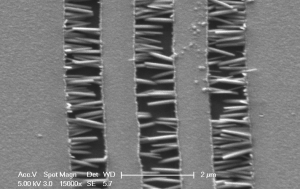Near-ultraviolet Sensor Based on Horizontal Low-Temperature Solution-Grown Zinc Oxide Nanowires
- Category: Electronic Devices, MEMS & BioMEMS, Nanotechnology, Optics & Photonics
- Tags: Akintunde Akinwande, Michael Swanwick
A near-ultraviolet (UV) sensor based on zinc oxide (ZnO) nanowires (NWs) that is sensitive to photo excitation at or below 400-nm wavelength has been fabricated and characterized. The device uses a single optical lithography step, and the NWs are grown at a low temperature from solution. ZnO is a wide direct band gap (3.37 eV) semiconductor whose absorption edge is in the near-UV range, making it an ideal near-UV photodetector. This is the first reported ZnO NW near-UV sensor that is insensitive to visible light (visible blind) and fabricated using a low temperature solution process [1] . At a voltage bias of 1V across the device, a 29-fold increase in current is observed in comparison to dark current when the NWs are photo excited by 400-nm light-emitting diode (LED), 8.91 µA (photo excitation current) vs. 311 nA (dark current).
The fabrication of the near-UV sensor device is based on a single optical lithography step with no processing steps that exceed 100°C. The devices are compressed of a thin ZnO film with a metal cap. The sidewall of the ZnO film within the material stack acts as a seed for lateral growth of ZnO NWs. The metal cap restricts vertical growth of the NWs and doubles as the device electrodes. The symmetric devices have multiple electrode shapes and gaps between the electrodes ranging from 1-20 µm. The horizontally grown ZnO NWs bridge the gap between the two electrodes. The wires vary in length from 0.8 to 8.4 µm and diameter from 80 to 300 nm, depending on growth time. The result is a self-aligned ZnO NW ‘visible blind’ near-UV sensor that utilizes a low temperature process and a simple one-mask optical lithography step that can be integrated on a flexible substrate.
- Figure 1: Horizontal growth of ZnO by low temperature hydrothermal method.
- Figure 2: Near-UV sensor design based on laterally grown ZnO nanowires.
- M. E. Swanwick, S. M.-L. Pfaendler, A. I. Akinwande, and A. J. Flewitt, “Near-ultraviolet sensor based on horizontal low temperature solution grown zinc oxide nanowires,” presented at 2010 MRS Fall Meeting, Boston, MA, Nov. 2010. [↩]

